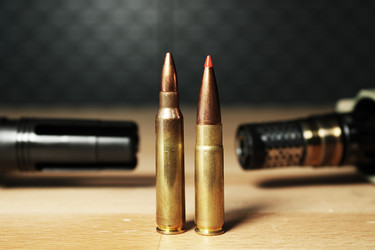300 BLK vs. 5.56 NATO: Which One's Better?
Posted by 80-Lower.com on Jun 16th 2025
300 BLK vs. 5.56 NATO: Which one's better? Is one better? (Yes). Which one should you pick for target shooting, self defense, short-barreled rifles, long-range accuracy? The answers to these questions might surprise you. We're covering ballistic data for both rounds and comparing their performance in depth to give you the answers.
Before we get into the data, let's see how these rounds' technical specifications compare.
300 Blackout vs. 5.56 NATO Specifications
5.56 NATO and .223 Remington are virtually identical when it comes to external case measurements, ballistic performance, and chamber pressure. So, we're lumping these two rounds together for this comparison.
300 Blackout Specifications
- Bullet Diameter: 0.308"
- Neck Diameter: 0.332"
- Rim Diameter: 0.378"
- Case Length: 1.368"
- Overall Length: 2.26"
- Case Capacity: 25.1 grains (H2O)
- Max Pressure: 55,000 PSI (SAAMI)
- Common Weights: 110, 125, 150, 220 grains
5.56 NATO Specifications
- Bullet Diameter: 0.224"
- Neck Diameter: 0.253"
- Rim Diameter: 0.378"
- Case Length: 1.76"
- Overall Length: 2.26"
- Case Capacity: 28.5 grains (H2O)
- Max Pressure: 56,565 PSI (CIP)
- Common Weights: 55, 62, 75, 77 grains
300 BLK vs. 5.56 NATO Ballistic Performance
You'd think 5.56 NATO has the advantage over 300 BLK when it comes to long-range performance. After all, 5.56 has a higher case capacity. More gunpowder, plus a smaller bullet, means more velocity and accuracy downrange, right?
Except that's only half true. Supersonic 300 BLK competes with 5.56 surprisingly well.
Supersonic 300 BLK vs. 5.56 NATO (16" Barrels)
Let's compare the performance of both rounds when they're fired from various barrel lengths, starting with the typical 16" barrel found on most AR-type rifles. For these comparisons, all rifles used in the data below are zeroed at 100 yards.
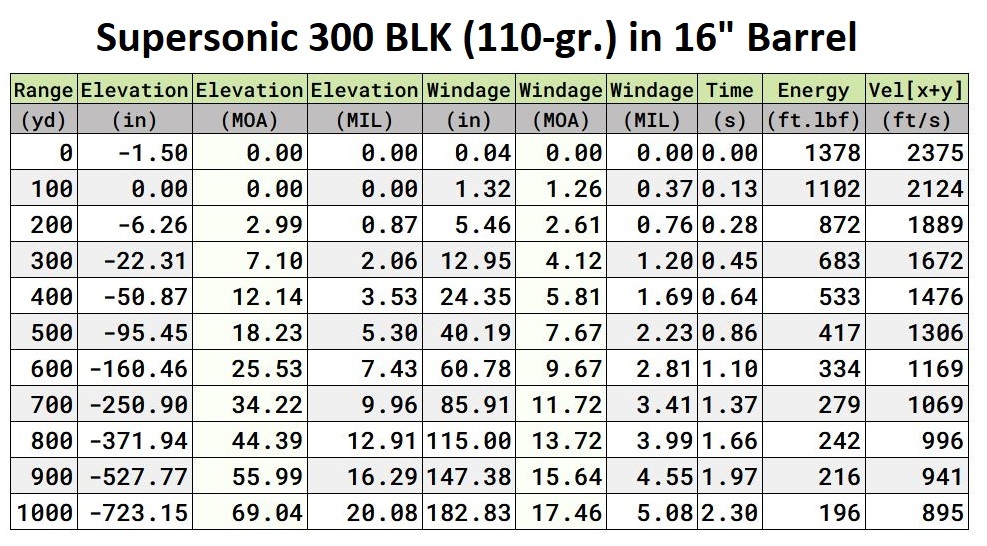
- Ballistic Coefficient: 0.290
- Muzzle Velocity: 2,375 FPS
- Muzzle Energy: 1,378 ft-lbs
- Wind Speed: 10 MPH
- Wind Direction: 90 Degrees
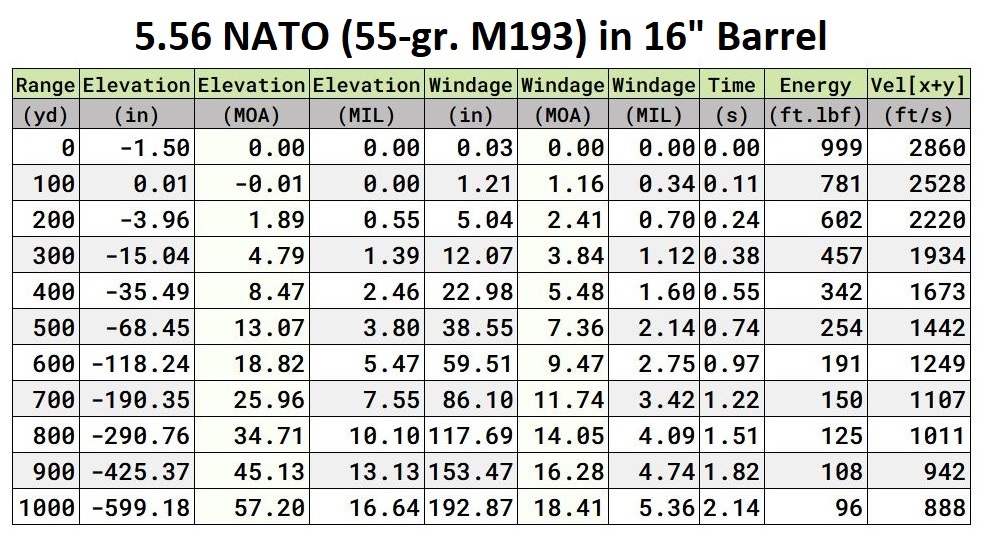
- Ballistic Coefficient: 0.243
- Muzzle Velocity: 2,860 FPS
- Muzzle Energy: 999 ft-lbs
- Wind Speed: 10 MPH
- Wind Direction: 90 Degrees
If we compare the lightweight loads for both calibers (110-grain 300 BLK and 55-grain 5.56), we find that 5.56 NATO produces more velocity at the muzzle and downrange, resulting in less bullet drop. At 500 yards, 5.56 drops 68", while 300 BLK drops 103". That's 66% less drop for 5.56.
But 300 BLK produces more energy at the muzzle and downrange. It produces 1,378 ft-lbs of energy at the muzzle, and retains 362 ft-lbs at 500 yards. 5.56 produces 999 ft-lbs of energy at the muzzle, and retains 254 ft-lbs at 500 yards. That's 28% less energy at the muzzle, and 30% less at 500 yards for 5.56.
Why 300 Blackout is Better Than 5.56 in 16" Barrels
In this case, 5.56 NATO may seem better for target shooting and accuracy, because it drops less. But 300 Blackout is the better caliber if you value takedown power and lethality, and if you're familiar with compensating for bullet drop with holdovers, 300 Blackout is, overall, the better caliber.
The differences in bullet drop compensation between 300 BLK and 5.56 NATO are not significant, either. You need to compensate for 18 MOA of drop with 300 BLK at 500 yards, while you need to compensate for 13 MOA of drop with 5.56 NATO at that same distance.
At shorter distances, the difference in bullet drop for both rounds is negligible. At 300 yards, 5.56 drops 15" while 300 BLK drops 22". Lastly, because 300 Blackout has a higher ballistic coefficient, its wind drift is practically identical to 5.56 NATO, despite its lower velocity.
Supersonic 300 BLK vs. 5.56 NATO (9" Barrels)
The advantages offered by 300 BLK become significant in short-barreled rifles. It obtains nearly maximum muzzle velocity in a barrel as short as 9", while 5.56 NATO suffers from a substantial loss in muzzle velocity and energy at this barrel length.
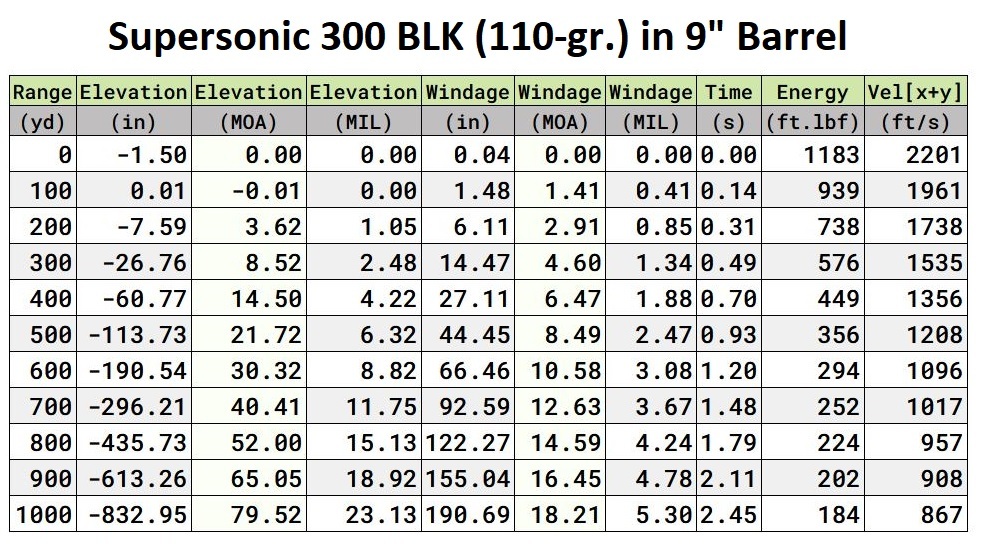
- Ballistic Coefficient: 0.290
- Muzzle Velocity: 2,201
- Muzzle Energy: 1,183 ft-lbs
- Wind Speed: 10 MPH
- Wind Direction: 90 Degrees
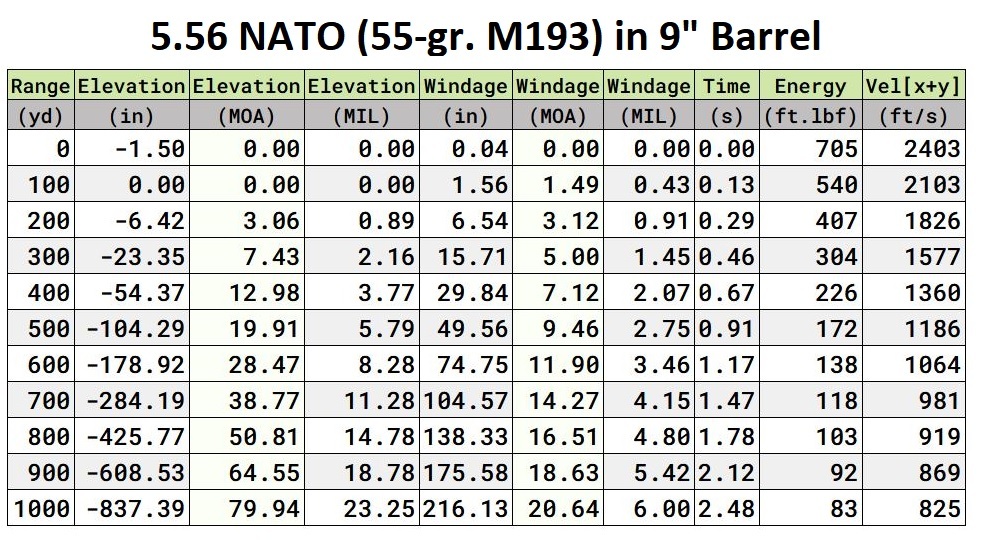
- Ballistic Coefficient: 0.243
- Muzzle Velocity: 2,402
- Muzzle Energy: 705 ft-lbs
- Wind Speed: 10 MPH
- Wind Direction: 90 Degrees
Comparing the same 110-grain and 55-grain loads, we find 5.56 NATO offers only slightly more velocity at the muzzle and downrange, resulting in nearly identical bullet drop when compared to 300 BLK. At 500 yards, 5.56 drops 104" while 300 BLK drops 114".
Meanwhile, 300 BLK produces significantly more energy than 5.56: 1,183 ft-lbs compared to 705 ft-lbs at the muzzle, and 356 ft-lbs compared to 172 ft-lbs at 500 yards. That's 40% more muzzle energy and 52% more energy at 500 yards, in 300 BLK's favor.
By the time both rounds reach 500 yards, 300 BLK's higher ballistic coefficient allows it retain more velocity, too. At this distance, it's traveling at 1,208 FPS while 5.56 is traveling at 1,186 FPS.
Why 300 Blackout is Far Better Than 5.56 in Short Barrels
The data speaks for itself: In a 9" barrel, supersonic 300 BLK offers far more takedown power and lethality than 5.56 NATO at all distances. It offers practically identical bullet drop out to 300 yards, too, and it suffers from less wind drift.
Most shooters agree that 5.56 NATO requires a minimum barrel length of 10.5". But even at this length, 300 Blackout generally offers better performance, particularly when it comes to muzzle energy and energy retention downrange.
Isn't Match-Grade 5.56 NATO Better Than 300 BLK?
Match-grade 5.56 NATO is only superior to supersonic match-grade 300 BLK at significant distances downrange. Let's compare the performance of 5.56 NATO chambering 77-grain Sierra MatchKing bullets against supersonic 300 BLK chambering 120-grain Tac-TX match bullets.
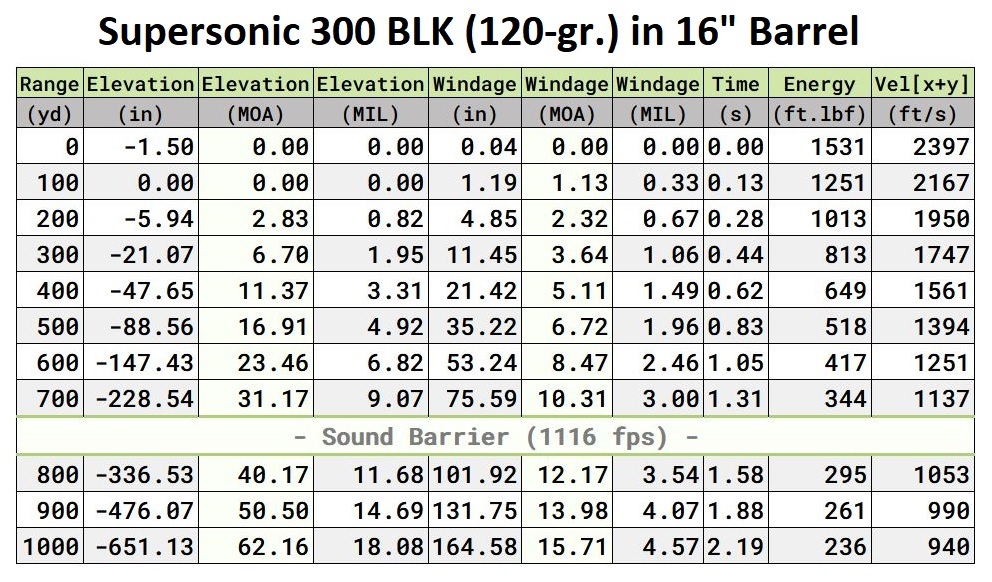
- Ballistic Coefficient: 0.358
- Muzzle Velocity: 2,397
- Muzzle Energy: 1,531 ft-lbs
- Wind Speed: 10 MPH
- Wind Direction: 90 Degrees
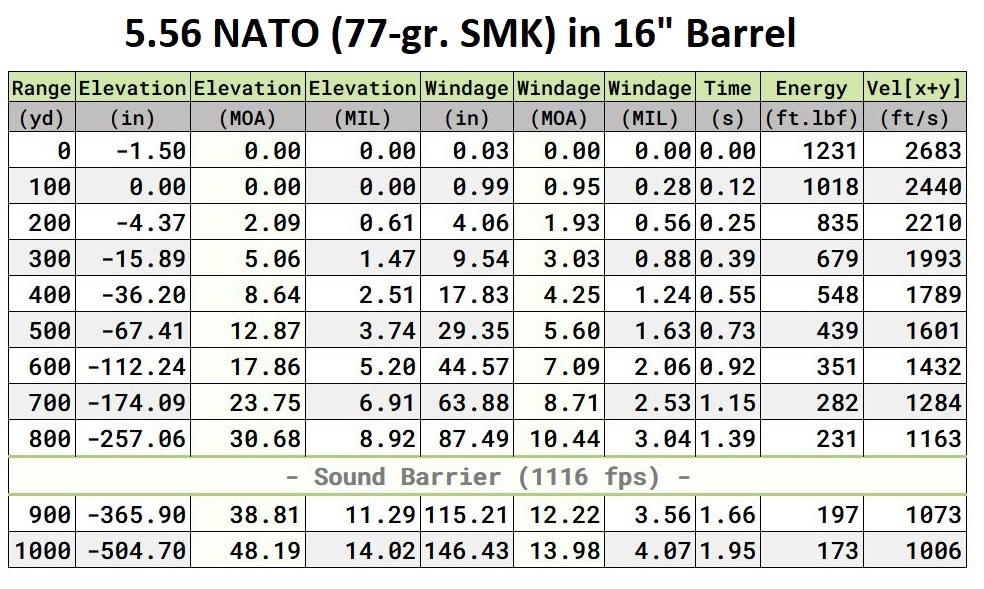
- Ballistic Coefficient: 0.372
- Muzzle Velocity: 2,683
- Muzzle Energy: 1,1231 ft-lbs
- Wind Speed: 10 MPH
- Wind Direction: 90 Degrees
When both loads are fired from 16" barrels, we find 5.56 NATO's match ammo offers slightly more muzzle velocity than 300 BLK -- 2,683 FPS versus 2,397 FPS, an 11% difference -- but this velocity advantage once again only translates into a modest improvement in bullet drop.
Both rounds require virtually the same MOA or MIL holdovers at 300 yards. At this distance, 300 BLK requires a 6.7-MOA (1.95-MIL) elevation holdover, while 5.56 NATO requires a 5-MOA (1.47-MIL) elevation holdover, with with no meaningful differences in bullet drop observed between the muzzle and 200 yards. The differences in bullet drop remain nearly identical out to 500 yards
Wind drift is also nearly identical for both rounds out to 500 yards. With a 10 MPH crosswind, 5.56 drifts 29" and requires a 5.6-MOA (1.6-MIL) windage holdover, while 300 BLK drifts 35% and requires a 6.7-MOA (1.9-MIL) windage holdover.
Once again, the 300 BLK offers the advantage where takedown power and lethality are concerned, producing 20% more muzzle energy and retaining 15% more energy than 5.56 NATO at 500 yards.
Match-grade 5.56 NATO only provides meaningfully better performance in bullet drop and wind drift beyond 500 yards. But at no point between the muzzle and 1,000 yards does it produce more energy than 300 BLK.
So, Which Round is Better?
5.56 NATO is the better round if you prefer less bullet drop. All 5.56 rounds also provide better performance at great distances when you're using a Maximum Point Blank Range (MPBR) zero. An MPBR zero is a zero distance that allows you to shoot at a target of a specific size without having to adjust for bullet drop.
In other words, an MPBR zero allows you to shoot at a target anywhere between 0 yards and "X" yards, with successful points of impact (POI) landing within plus or minus "X" inches from the point of aim (POA). Most shooters agree that a difference of plus or minus 2" (or a hit box measuring 4" tall) between POI and POA is acceptable.
If you zero 55-grain 5.56 NATO in a 16" barrel using the generally suggested +/- 2" difference between POA and POI, you can obtain an MPBR zero that allows you to shoot at targets out to 225 yards. For 110-grain 300 BLK fired from a 16" barrel, the same +/- 2" MPBR zero will allow you to shoot out to 194 yards.
300 Blackout is the better round if you prefer more power, or if you're using an SBR. All supersonic 300 BLK loads offer significantly more energy than all 5.56 NATO loads, especially when chambered in a short-barreled rifle. In any SBR equipped with a barrel less than 10" long, 300 BLK will be ballistically superior to 5.56 NATO, and in an SBR with a longer barrel (like 10" to 12"), 300 Blackout will still compete with 5.56 NATO when it comes to bullet drop, while providing far more power.
5.56 NATO is More Affordable
In addition to being a flatter and generally "easier-to-shoot" target round, 5.56 NATO is far more affordable than 300 Blackout. As of 2025, the cost of 55-grain (M193) ammo is approximately $0.50 per round. Match-grade ammo averages $0.90 to $1.50 per round.
Meanwhile, 110-grain 300 BLK loads average $0.80 to $1.50 per round, while subsonic loads cost $1.25 to $2.50 per round. Somewhat ironically, match-grade 300 BLK rounds (like the Phantom Defense "Specter" 120-grain ammo we discussed above) are some of the most affordable, costing as little as $0.60 per round at the time of this article's publication.
Still, 5.56 NATO is generally the cheaper investment.
Shooting Suppressed? It's No Competition
300 Blackout is far superior to 5.56 NATO when shooting suppressed. This round was specifically designed to offer the best suppression of any rifle round and, when paired with a quality .30-caliber suppressor, it can be made hearing-safe.
All 5.56 NATO loads will remain supersonic in flight, significantly reducing their ability to be suppressed effectively. There are no loads available today that offer truly hearing-safe sound suppression.
DISCLAIMER: If you are new to the world of DIY gun building, you likely have a lot of questions and rightfully so. It’s an area that has a lot of questions that, without the correct answers, could have some serious implications. At GunBuilders.com, we are by no means providing this content on our website to serve as legal advice or legal counsel. We encourage each and every builder to perform their own research around their respective State laws as well as educating themselves on the Federal laws. When performing your own research, please be sure that you are getting your information from a reliable source.

